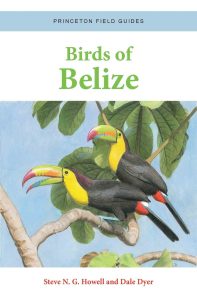Go to All Blogs | Bird Book Reviews | Recommended Bird Field Guides Blogs | Neotropics Birding Tours | All our Birding Tours
Book review: Birds of Belize by Steve N. G. Howell and Dale Dyer – Princeton University Press 2023
This book review of this field guide to the Birds of Belize was written by Chris Lotz on 4 April 2023
This compact book is well worth purchasing if you are planning a trip to Belize. If you are wanting to visit other Central American countries in the near future as well, then you might seriously consider buying the much more extensive (and excellent) Birds of Central America field guide shown at the top of our “Recommended field guides for the neotropics” blog, which deals more comprehensively with a larger chunk of the region including Belize southwards to Costa Rica and Panama. Belize is of course a great, easy, manageable place to start your neotropical or Central American birding exploits, and by having this Belize-only book, studying for the trip will be easy. Also, this book is compact and light enough to put into your day pack and take with you while out birding. So, I would certainly take this book with me if I was doing a Belize-only birding trip.
This is a typical good modern birding field guide with distribution maps, concise text including helpful identification notes, and illustrations all on the same page. This all makes it a very easy field guide to use.
The paintings are good and quite accurate although the colors are a bit washed out and do not give justice to how dazzling many of these tropical bird species are in reality.
Regarding taxonomy and common names chosen, the authors mention that the IOC is basically followed, but with exceptions made at their discretion. The exceptions have advantages and disadvantages, depending on your perspective. I find it confusing to see a bird named “Smithsonian Gull” just when I’ve grown accustomed to the name “American Herring Gull” (since the split from the European form of this superspecies). The authors do explain their justification for this and other changes (relative to the IOC) in their Appendix B, but I am still not a fan of introducing yet more additional common names into the birding world as it is confusing to have different names for the same birds. Besides name changes like this, the authors also treat a number of species as “split” even though major world lists (the IOC being the most relevant one here) have not made these splits yet. An example is “Cayenne Lapwing”, and the authors explain why they believe this should (perhaps) be treated as a separate species from the ubiquitous Southern Lapwing. I am sure that a great many birders will enjoy these proposed splits and will appreciate being informed about them in this book, although the species aren’t yet officially “tickable” by major world lists. There is also at least one example where the authors have lumped a species (Osprey, as they explain that the split into Eastern and Western doesn’t make sense to them; the IOC actually has already re-lumped Osprey anyway though).
The book contains a good introduction including a section on how to use the book, and a “Biogeography” section with tantalizing habitat photos.
In summary, I would recommend this quite good, compact field guide if you’re heading to Belize.

